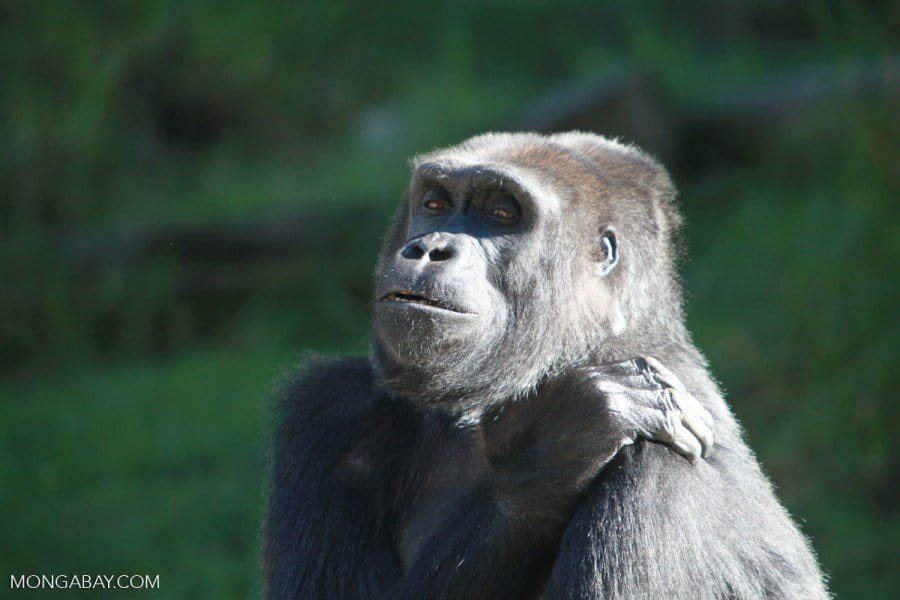- Study found that in African and Asian countries with great apes, scientists tend to focus on few big national parks while ignoring many others.
- Researchers found that 71 percent of published studies focused on mammals, while 31 percent focused on great apes alone.
- Such bias could mean that knowledge of conservation today could become less applicable in the future, researchers say.
For scientists, not all species are equal. In tropical Asia and Africa, for example, scientists tend to focus on a handful of large national parks that are home to high-profile species of great apes, a new study published in the journal Frontiers in Ecology and the Environment has found. And this bias means we know next to nothing about most protected areas, researchers say.
“I find these findings quite alarming, not because big national parks with apes aren’t important, but that research effort seems to be so strongly concentrated in these areas,” William Laurance, a distinguished research professor at James Cook University who was not involved in the study, told Mongabay.
Previous studies have found that conservation scientists do have strong preferences when it comes to selecting species to study. To find out if this is true in the paleotropics, anthropologist Andrew J. Marshall of University of Michigan in the U.S., and his colleagues, turned to Google Scholar to see whether the presence of great apes — gorillas (Gorilla spp), chimpanzees (Pan troglodytes), bonobos (Pan paniscus), and orangutans (Pongo spp) — influences where researchers work.
They searched for scientific publications that contained the names of one or more of the 565 African and Asian protected areas in which great apes are known to occur, and used the number of returned citations (or “hits”) on Google Scholar as a proxy for research effort in each protected area.

The researchers found unexpected results. Of the 52,502 scientific publications that their search retrieved, more than 50 percent focused on just 17 protected areas. Research effort was also substantially higher in big national parks than other types of protected areas.
Moreover, more than one-third of African and one-fifth of Asian protected areas did not return a single hit on Google Scholar.
“The study suggests that scientists need to get a lot more democratic in how we allocate our research effort,” Laurance said. “There are many, many protected areas about which we know very little scientifically. If I were a wealthy philanthropist I’d set up a special fund solely to promote research in such poorly-studied places.”
Marshall’s team also found that 71 percent of the scientific papers focused on mammals, while 31 percent focused on great apes alone. Among the great apes, the researchers found that gorillas attracted most research effort, followed by orangutans, chimpanzees and bonobos.
“These are a small proportion of total biodiversity in the tropics, but attract the lion’s share of research effort,” Marshall said. “We imagined that research allocation might be skewed, but did not envisage such a strong bias.”
The study, however, does not analyze the possible reasons for these biases. “We could not gather in-depth information on all of the 52,000 papers that our searches returned,” Marshall said.
He suspects, though, that the bias in research efforts could simply be because many researchers are drawn to charismatic taxa, just as other people are. Laurance adds that the bias towards great apes could also be because areas with great apes are better-known nationally and internationally and so may have better research facilities to support scientists.

The bias towards big national parks, Marshall said, could be because large, well protected parks are more appealing places for researchers to live and work. “They are probably also more stable, and therefore safer places to establish long-term research stations than more marginal or less well managed areas,” he added.
Marshall also speculates that there could be an intellectual bias towards conducting and funding research in “pristine” areas that are relatively undisturbed by human activity. “And large national parks are most likely to provide these conditions,” he said.
But this bias means that there are glaring research gaps: we know almost nothing about many protected areas in the tropics, and we know very little about most non-mammalian species in the region.
This lack of even the most basic information about many protected areas, Marshall said, means that we do not know what species these protected areas contain or what the local threats or conservation opportunities may be. “Ignorance of these basic facts means that our conservation prioritization is based on an incomplete knowledge, and is therefore less effective than it could be.”
The presence of researchers within protected areas — both big and small — can also have other conservation benefits. For example, scientists can exert a strong “safe-guarding effect” when they work in a protected area, Laurance said. “Poachers and encroachers tend to avoid areas frequented by scientists, and scientists often work in a variety of ways to build local, public, and international support for parks,” he added.
The study concludes that our current information on species and protected areas in the tropics is very limited and biased. And this could mean that our knowledge of conservation today could become less applicable in the future, Marshall said.
“The future of tropical forests is that they are becoming increasingly fragmented,” he said. “This means that animals will live in progressively smaller and smaller patches of forest. If our knowledge of threatened species and ecosystems is based primarily on data collected in the places where populations are well protected and ecosystems are functioning best, we likely have a dangerously optimistic view of the world.”
Citation:
- Marshall AJ, Meijaard E, Cleave EV, and Shell D (2016) Charisma counts: the presence of great apes affects the allocation of research effort in the paleotropics. Front Ecol Environ 2016; 14(1): 13–19, doi:10.1002/14-0195.1